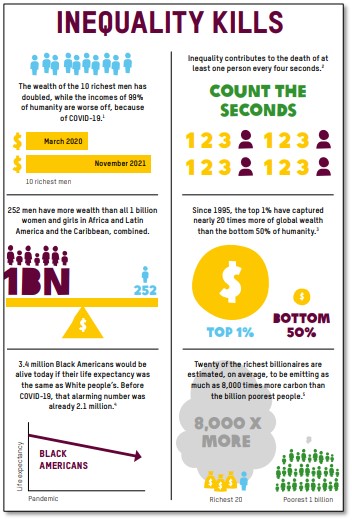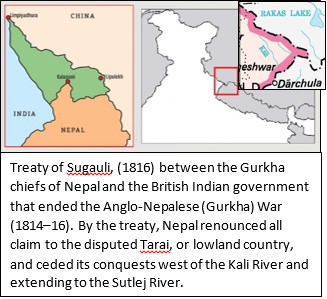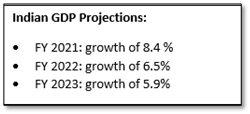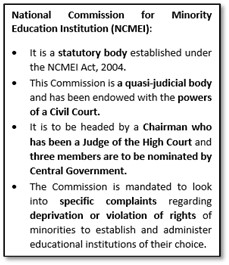Wednesday, 19th January 2022
Web 3.0
In News
Web3, also called Web 3.0, the potential next phase of the internet has gained quite a significance in 2021.
About the News
- The Web 3.0 model is a decentralised internet that will be run on blockchain technology.
- It is different from the Web 1.0 and Web 2.0 versions that are currently in use in terms of ownership wherein the web3 users will have ownership stakes in platforms and applications unlike the current situation where tech giants control the platforms.
Understanding Web 1.0 and Web 2.0.
- Web 1.0:
- It is the World Wide Web or the internet that was invented in 1989 and lasted till 1999.
- The internet here was mostly static web pages where users read and interact with the static information from any website.
- Even though there were e-commerce websites in the initial days it was still a closed environment and the users themselves could not create any content or post reviews on the internet.

- Web 2.0:
- It started in the late 1990s, though its features were fully available only in 2004.
- We are still in the age of Web 2.0.
- The differentiating characteristic of Web 2.0 compared to Web1.0 is that users can create content. They can interact and contribute in the form of comments, registering likes, sharing and uploading their photos or videos and perform other such activities.
- Social media kind of interaction is the differentiating trait of Web 2.0.
- Concerns relating to Web 2.0: In Web 2.0, most of the data in the internet and the internet traffic are owned or handled by very few giant companies that has created issues relating to data privacy, data security and abuse of such data.
So how will Web3 address the problems of data monopoly?
- Web3 will deliver decentralized and fair internet where users could control their own data.
- For instance, currently if a seller has to make a business to the buyer, both the buyer and seller need to be registered on a “shop” or “platform” like Amazon or Ebay or any such e-commerce portal that authenticates that the buyer and seller are genuine parties for the transaction.
- However, Web3 would remove the role of the “platform” and just uses usual proofs aided by block chain technology to authenticate the buyer and the seller.
- With block chain, the time and place of transaction are recorded permanently. This concept can be extended to other transactions also.
- Thus, the key concepts in Web3 seen so far are:
- Peer to peer transaction
- Block chain and
- Decentralized Autonomous Organization (DAO) where all the business rules and governing rules in any transaction are transparently available for anyone to see and software will be written conforming to these rules.
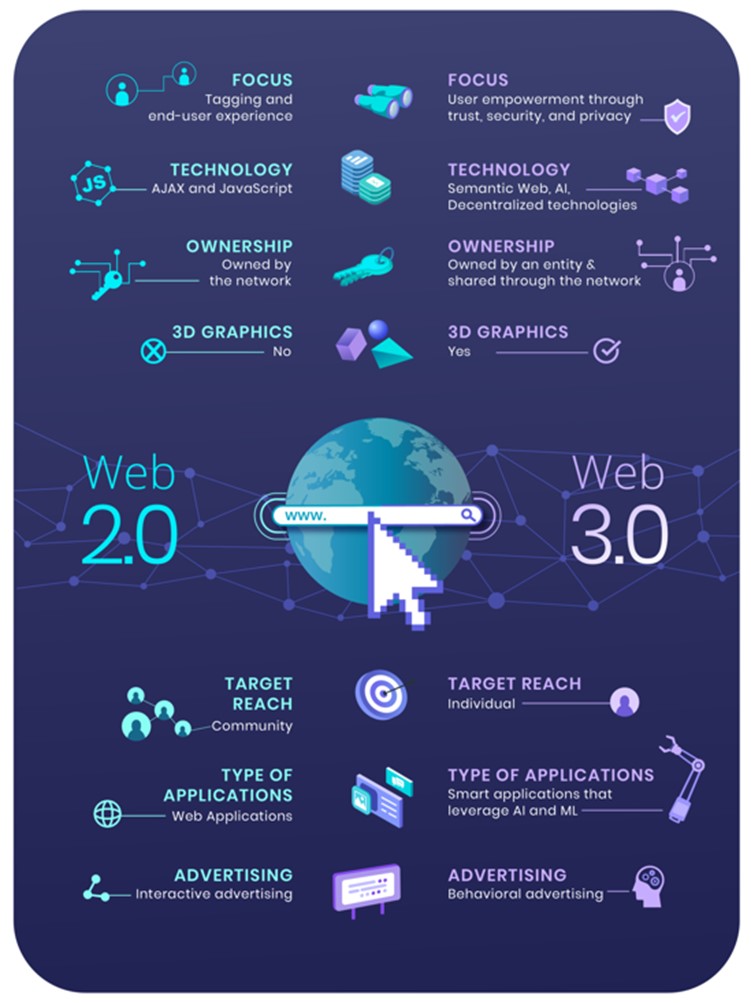
Source:
Antrix-Devas deal
In News
The Supreme Court has upheld the liquidation of Devas, a start-up headquartered in Bengaluru which had signed a 2005 satellite deal with Antrix Corporation — the commercial arm of the Indian Space Research Organisation (ISRO).
A brief history
- In the aftermath of the fallout of a deal between Devas and Antrix in 2011 due to security purposes, Devas and its foreign investors approached various international tribunals and courts seeking compensation where they were awarded compensation.
- By 2016, Enforcement Directorate (ED) and the CBI had filed a chargesheet against some officials from Devas, ISRO and Antrix linked to the deal.
- Antrix filed a plea in the National Company Law Tribunal in January 2021 for liquidation of Devas in India, which it said was incorporated in a fraudulent manner. On May 25, the NCLT ordered the liquidation, which was upheld by the National Company Law Appellate Tribunal and by the Supreme Court.
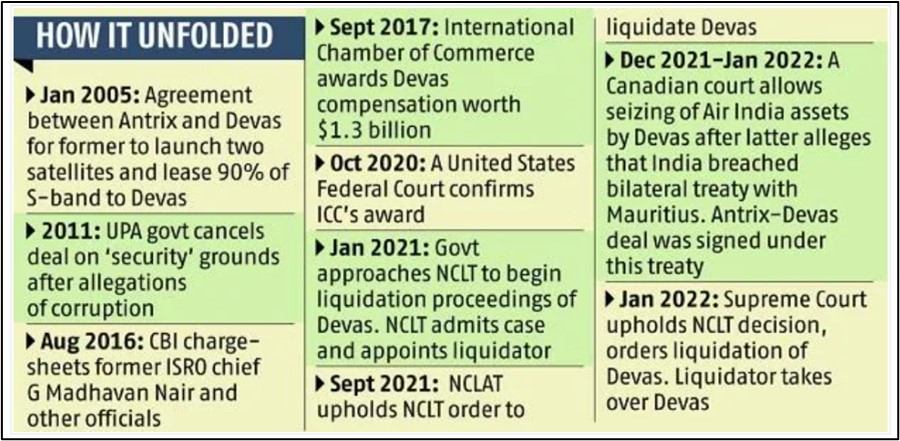
Various International Arbitrators involved in the case
- International Chamber of Commerce (ICC) :
- ICC is the world business organization consisting of companies from over 100 countries.
- ICC has three main activities: rule setting, dispute resolution, and policy advocacy.
- ICC was the first organization granted general consultative status with the United Nations Economic and Social Council and UN Observer Status.
- ICC India is one of the most active chapters of the ICC.
- United Nations Commission on International Trade Law (UNCITRAL):
- UNCITRAL is the core legal body of the United Nations system in the field of international trade law, with a mandate to further the progressive harmonization and unification of the law of international trade.
- It promotes, prepares and recommends Model laws which are legislative text, for enactment as part of national laws. For eg. 1985 UNCITRAL Model Law on International Commercial Arbitration, and coordinates the work of active organizations.
- The UNCITRAL Arbitration Rules provide a comprehensive set of procedural rules upon which parties may agree for the conduct of arbitral proceedings arising out of their commercial relationship and are widely used in ad hoc arbitrations as well as administered arbitrations.
- The Permanent Court of Arbitration
- The Permanent Court of Arbitration, established by treaty in 1899, is an intergovernmental non-UN organization providing a variety of dispute resolution services to the international community.
- The cases span a range of legal issues involving territorial and maritime boundaries, sovereignty, human rights, international investment, and international and regional trade.
National Company Law Tribunal
- The Central Government has constituted National Company Law Tribunal (NCLT) under the Companies Act, 2013.
- NCLT is a quasi-judicial authority incorporated for dealing with
- Corporate disputes that are of civil nature arising under the Companies Act.
- Pending before the Board for Industrial and Financial Reconstruction (BIFR), including those pending under the Sick Industrial Companies (Special Provisions) Act, 1985;
- Pending before the Appellate Authority for Industrial and Financial Reconstruction
- Pertaining to claims of oppression and mismanagement of a company, winding up of companies and all other powers prescribed under the Companies Act.
National Company Law Appellate Tribunal
National Company Law Appellate Tribunal (NCLAT) was constituted under Companies Act, 2013 for hearing appeals against the orders of NCLT.
Sources:
Republic Day Tableau
In News
Some states have raised concerns over the selection of tableau for the Republic Day parade
About the News
- Every year government invites all the states, the Union Territories, Central Government departments, and a few constitutional authorities to participate in the parade through tableaux.
- Tableaux refers to a group of models or motionless figures representing a scene from a story or from history. On the Republic Day, states and different departments and ministries showcase their achievements in forms of cutting-edge technology and instruments, or their history and culture in their respective tableaux.
- Ministry of Defense is responsible for the Republic Day parade and the celebrations of republic day.
- Theme for this year was around 75 years of India’s Independencee., India@75 – Freedom struggle, Ideas @ 75, Achievements @ 75, Actions @ 75 and resolve @ 75.
- From this year, republic Day celebrations will start from January 23 to include Netaji Subhash Chandra Bose’s birth anniversary.
How are Republic Day tableaux designed and selected?
- Expert committee: Ministry of defense constitutes an expert committee of distinguished persons from fields like art, culture, painting, sculpture, music, architecture, choreography, etc, to help in shortlisting the tableaux from the proposals.
- Stages of Scrutiny: First, the submitted sketches or designs of the proposals are scrutinised by this committee, which can make suggestions for any modifications in the sketch or design. The final selection is done on the basis of various criteria including visual appeal, impact on the masses, idea/ theme of the tableaux, degree of detail involved, accompanying music, among other factors.
What are the important features of the Tableaux?
- The participants should showcase elements relevant to their state/ UT/ department, within the overarching theme.
- The tableaux of two different states/ UTs cannot be too similar as the tableaux and should showcase the diversity of the country.
- The tableaux cannot have any writing or use of logos, except for the name of the state/ UT/ department, which should be written in Hindi on the front, English on the back, and a regional language on the sides.
- Participants should use eco-friendly material for the tableaux, and avoid the use of plastic or plastic-based products.
- The sketch used in tableaux should be simple, colourful, easy to comprehend and should avoid unnecessary detail. It should be self-explanatory, and should not need any written elaboration.
- If there is a traditional dance involved with the tableau, it should be a folk dance, and the costumes and musical instruments should be traditional and authentic. The proposal should include a video clipping of the dance.
- The Defence Ministry provides each participant with one tractor and one trailer, and the tableau should fit on that.
Sources:
Debendranath Tagore Death Anniversary
On January 19, 1905 Debendranath Tagore died. Debendranath Tagore was a reformer and philosopher. He was an active participant in the Brahmo Samaj in 1848, he founded the Brahmo religion. He was the father of the famous poet and Nobel prize winner, Rabindranath Tagore. Taking inspiration from Raja Ram Mohan Roy’s Brahmo Sabha (later Brahmo Samaj), Brahmoism was a reformist religion that was critical to the Bengal Resistance of the 19th century. It relied heavily upon readings of the Upanishads, of which Debendranath became a master, or ‘Maharishi’, as he was later nicknamed. He ran a separate theological society called Tatwabodhini Sabha, but later decided to merge the two and take over the Brahmo movement. As he aged, Debendranath became more reclusive, withdrawing from the bustle of the religion he founded, and seeking a more peaceful environment. In the 1860s, he moved to Santiniketan — which was to become synonymous with his son Rabindranath — where he continued to read scriptures and ponder the limits of Brahmoism.
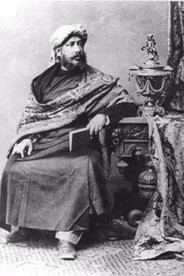
Source:
India State of Forest Report 2021
In News
The Ministry of Environment, Forest and Climate Change (MoEFCC) released the biennial India State of Forest Report (ISFR) 2021.
About ISFR
- ISFR is a biennial exercise by the Forest Survey of India (FSI), which does the assessment of forest cover of the country using mid-resolution satellite data.
- The ISFR-2021 provides information on forest cover, tree cover, mangrove cover, growing stock and carbon stock in India’s forests, forest fire monitoring, and forest cover in tiger reserve areas, above ground estimates of biomass & climate change hotspots in Indian forests.
- In the current report, FSI has introduced a new chapter related to the assessment of forest cover in the tiger reserves, corridors, and lion conservation area of India.
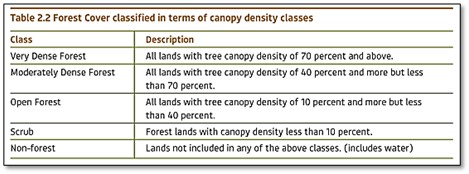
Key Terms and Definitions used
- The 'Forest Cover' refers to all tree patches that have canopy density of more than 10% and area of one hectare or more in size, irrespective of land use, legal status and ownership. It may include orchards, bamboo, and palms etc. and is assessed through remote sensing.
- The 'Recorded Forest Area' (RFA) or 'Forest Area' refers to all the geographical areas recorded as 'Forests' in government records irrespective of the actual trees growing on such lands. RFA mainly comprises of Reserved Forests (RF) and Protected Forests (PF) and Unclassed Forests notified under Indian Forest Act, 1927 or respective State Forest Acts.
- Trees outside Forest (TOF) refers to all trees outside the RFA irrespective of size of the patch.
- Tree Cover means patches of trees as well as isolated trees outside the RFA on areas less than one hectare. Hence, the trees included in Tree Cover constitute only a part of TOF and therefore, the former is a subset of the latter.
State of Forests in India- Key Findings of ISFR 2021

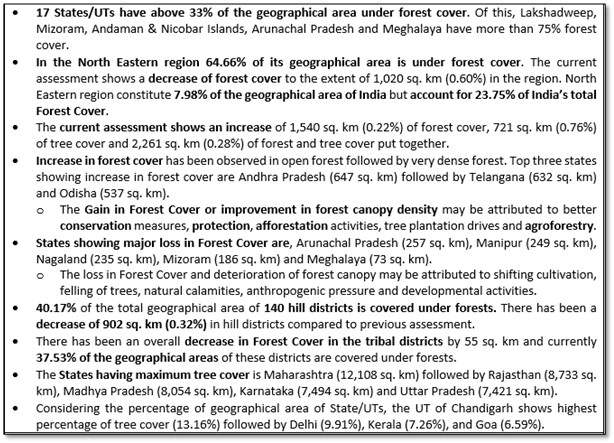

Concerns
- Losing Natural Forests: India’s green cover in very dense forest (VDF) and open forest (OF) categories have grown but the country has lost about 1,582 sq km of the moderately dense forest (MDF).
- The loss has been compensated by an improvement in the health of some of the protected areas and reserve forests. But a large part of the increase is due to more areas coming under plantations, which are no substitute for natural forests when it comes to providing critical ecological services.
- Loss in North East: The loss of more than 1,000 sq km of natural forests in the Northeast is worrying. This could have a bearing on the health of aquifers in the region, where water scarcity is already a serious problem.
- Losing natural habitat in Tiger Reserves: The loss in the forest cover of some of the tiger reserves, including the Sunderbans, is also a cause for concern.
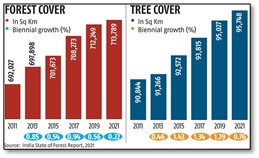
- Slowing rate of tree and forest growth: India’s forest cover growth has slowed to an eight-year low in 2021, with just 0.22% increase over 2019, down from 0.85% in 2013 and 0.94% in 2017. Similarly, the growth in tree cover is 0.76% in 2021 over 2019, the lowest rate since 2015.
- Increase in forest fire incidents: Between November 2020 and June 2021 period, 345,000 incidents of forest fire were detected by FSI sensors, a 177% increase over incidents detected during November 2019-June 2020.
- Assessment methods: Questions are being raised about assessment methodology, definition of a forest, map data and their verifiability.
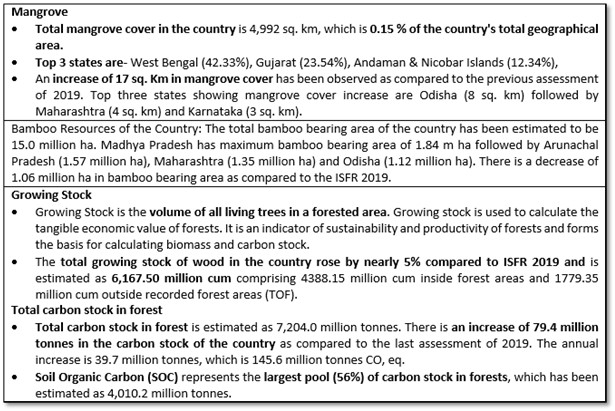
Question: The India State of Forest 2021 reflects significant improvement in forests cover in India, but it is accompanied with some serious concerns. Elaborate.
Sources:
New species of deep-sea mollusc
This is image of a new species of wood-boring, deep-sea mollusc, which has been found in the Arabian sea. The mollusc was spotted off the Karwar coast. It belongs to the family Xylophagaidae from the eastern Arabian Sea. A mollusc is an animal such as a snail, clam, or octopus which has a soft body. Many types of mollusc have hard shells to protect them. The wood-boring, tiny mollusc species has been named Xylophaga nandani. The discovery is also significant in that this is the first time that a member of the genus Xylophaga is being recorded from the Arabian Sea. Members of the family Xylophagaidae are deep-sea dwellers, their presence recorded even at depths of 7,000 metres. Commonly found on wood that plunge to great depths, rarely they are also found on wood drifting on the ocean. They use their shells to cut wood into tiny grains and use it as a source of energy. ''The word 'xylophaga' itself denotes 'wood eating
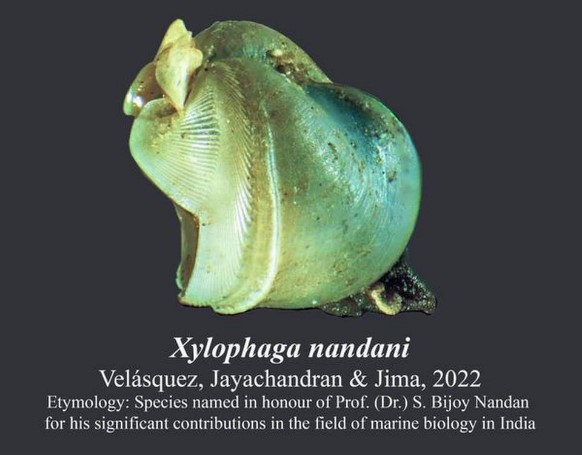
Source:
National Start-up Awards 2021
- Context: The Department for Promotion of Industry and Internal Trade (DPIIT) has announced the National Startup Awards 2021.
- The National Startup Awards have been conceptualized to further strengthen the startup ecosystem in the country.
- The award recognizes and rewards excellent entrepreneurs and ecosystem enablers who foster innovation and introduce competition into the economy.
- The contribution to the social good is measured in addition to the financial rewards for the investors.
- The participating startups are expected to focus mainly on five areas that include:
- Develop solutions & content in Indic languages.
- Encourage products & solutions that have a larger social & economic impact.
- Promoting Startups in every district across the country, - Establish ‘Startup Access centers’ in every district.
- Creating Innovation zones at the level of Urban Local Bodies.
- Adopt best practices from across the globe & enhance India’s global competitiveness.
Source:
Twindemic
- Context: The scientific community have recently warned about a possible ‘Twindemic’ amid COVID-19.
- 'Twindemic' is the co-occurrence of both the flu and the novel coronavirus.
- Although the flu and Covid-19 viruses differ in their pathogenesis, they have a cooperative effect causing both the cases to rise simultaneously. The flu virus globally kills about 650,000 a year as estimated.
- The flu viruses started circulating in Europe around late 2021 at a 'higher-than-expected rate', parallelly with Covid-19 virus.
- This puts excessive pressure on the already exhausted healthcare systems and will be challenging for doctors in distinguishing between flu and Covid-19 viruses.
- There are various reasons for Twindemic in 2021 like:
- Easing of restrictions after Delta resulted in increased mixing within populations across the world.
- Lax approaches to social distancing and mask-wearing likely increased rates of transmission.
- Low influenza infections in 2020 resulted in reduced immunity to Influenza for the subsequent year.
- Increased rates of transmission are expected due to increased exposure to more virulent strains.
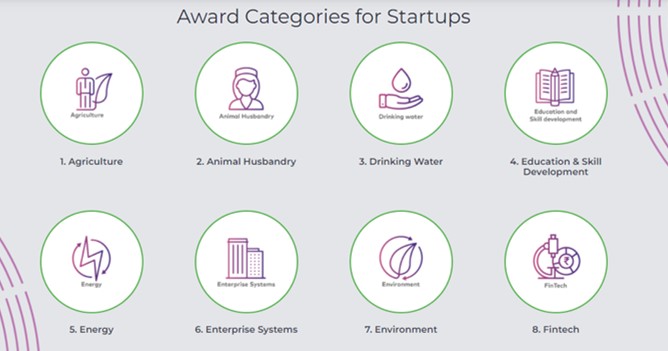
Source:
Weather Hazard Atlas
- Context: The Indian Meteorological Department (IMD) has recently launched India's first weather hazard atlas.
- The atlas is first of its kind, designed to mitigate the effects of the 13 most hazardous meteorological events that include heat waves, cold waves, thunderstorms, floods, drought, fog, wind hazards, dust storms, snowfalls, hailstorms, lightning, extreme rainfall and cyclone – that can cause extensive damage.
- For a visual display of the climate vulnerability maps, the weather bureau has used geographic information system tools at the office of climate research and services office in Pune.
- It will thus aid in disaster preparedness (adaptive and preventive measures) of such extreme weather events which are on persistent rise in the wake of the current climate crisis.
- It will act as a reference for impact-based warnings that we issue for various regions, which people can also see the atlas to understand what is the impact of certain extreme weather events in their region.
- It can be used to plan climate-resilient infrastructure. For example, if a construction is coming up in a coastal area, the atlas can give crucial information on what kind of disasters are probable in that area.
- According to the Atlas,
- The Sunderbans in West Bengal, Odisha, and Ramnathpuram, Pudukottai, and Thanjavur in Tamil Nadu are the most vulnerable to cyclone.
- Storm surges are a threat in Andhra Pradesh's Prakasam, Guntur, and Krishna districts, as well as Gujarat's Bhavnagar and Kachh, and all of the west coast's coastal regions.
- In contrast, East Godavari, Prakasam, Krishna, West Godavari on the east coast, Ratnagiri, Sindhudurg, south Goa and Uttara Kannada on the west coast are most likely to experience rainfall associated with severe cyclones in the 50 -60 cm range.
Source:
Vulnerable witnesses
- Context: The Supreme Court has expanded the meaning of vulnerable witnesses.
- Vulnerable witnesses will not be limited to mean only child witnesses, but will include age-neutral victims of sexual assault, gender-neutral victims of sexual assault, age and gender neutral victims of sexual assault under section section 377 IPC (unnatural offences), witnesses suffering from mental illness as defined in Mental Healthcare Act, witnessses with threat perception and any speech or hearing impaired individual or person suffering from any other disablity who is considered to be vulnerable by the court concerned.
- A vulnerable witness a witness who can be more easily attacked in traditional adversarial court proceedings.
- The Supreme court also directed that all HC’s adopt and notify a Vulnerable Witness Deposition Centre (VWDC) scheme within a period of two months. Every HC should set up a permanent VWDC committee
- As per SC’s order, HC’s need to ensure that there is one VWDC in each district. In states where Alternate Dispute Resolution (ADR) centers have been set up in close proximity to the court complexes, the HC’s will be at liberty to ensure that a VWDC is made available within the premises of the ADR centre.
- It also asked the Union Ministry of Women and Child Development to designate a nodal officer for coordinating the implementation of its directions and facilitating logistical support to the Chairperson.
Source:
Reciprocal Exchange of Logistics Agreement: IDSA
Essence: The editorial focuses on the multifold advantages of the yet-to-conclude Reciprocal Exchange of Logistics Agreement (RELOS) between India and Russia. Firstly, the agreement would ensure that both countries have access to logistics, port facilities at each other bases during times of war and peace, both. They’d be able to replenish supplies, ration, fuel, weaponry, etc during times of need at mutually. Noteworthy, India has signed such exchange cooperation with all Quad members, France, Singapore, South Korea and is processing the same with Vietnam and UK as well.
Second, through RELOS, India will have a greater access to Arctic region (Northern Sea Route) and would help Russia in exploring petroleum resource around the Arctic. Thirdly, this will lead to a wider connectivity for India in Indo-Pacific region, alongside the CVMC, from Vladivostok to Murmansk. Fourth, it would help in counterweighing China’s claims of Arctic as its near-neighbor and reshuffle the Russia-China geo-politics. Lastly, climatic research in Arctic areas would help to understand India’s own complex weather and monsoon systems.
Why you should read this article?
- To understand the strategic significance of RELOS for India and Russia.
- To understand the wider implications of outreach and evolving geo-politics due to India’s participation in the Arctic region.
Source:
Let us raise a toast to family entrepreneurship in India: LM
Essence: The article talks about Indian entrepreneurship system in the light of recent study from Stanford. The study mentions that four of every 10 unicorn founders in the US happens to be first-generation immigrants, with those of Indian origin the most numerous. Entrepreneurship is something which is not new in India but is different from VC/PE funded startups. These startups focus more on increasing their valuations so that they can exit thereby making profits. But that is not the case with family entrepreneurship.
But there are reasons that the family ventures fails. One of it being that they focus more on narrow and short-term goals rather than on creating and fulfilling long term goals. Another being the risk taken by the corporate intrapreneurs which is higher than taken by the family entrepreneurs. The time is ripe to combine social and intellectual capital to ensure utilization of country’s greatest strength which is family businesses.
Why you should read this article?
- To understand the nature entrepreneurship in India.
- To understand how corporate entrepreneurship differs from family entrepreneurship in India.
Source:
Padmashree Dr. Hukumchand Patidar
Background
- Hukumchand Patidar (Farmer), from Rajasthan was felicitated by Padma shri award in 2018 for his exemplary contribution in chemical-free Organic Farming.
- Patidar,a small farmer and school dropout , has been included in a team of scientists and academics, assigned with the task of designing the curriculum on organic farming for India's agricultural universities.
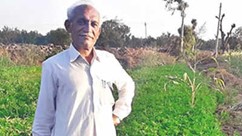
How did Dr. Hukumchand Patidar evolve?
- Ecological view: Patidar, followed ancient texts like manuscripts, vrikshavedas and inherited the skill of organic farming using the ‘Panchgavya’ method (five elements derived from cows). This method helped productivity and enhanced the carbon cycle of soil.
- Economical view: He strengthened the local farmers of Rajasthan by awaking them in growing organic oranges, pulses, onion, coriander and fennel. Today, the bulk of his farm produce is exported to Europe.
- Currently, he has been included in the national curriculum committee as a consultant set up by the Indian Council for Agriculture Research because of his expertise. (Only committee member without a degree)
- He has a strong believe that, agricultural knowledge cannot be just given through degrees like BSc, MSc and PhD but ideally students should get introduced right from the schools.
Quote: “No race can prosper until it learns there is as much dignity in tilling a field as in writing a poem.” - Booker T. Washington.
Source:
Share the article
Get Latest Updates on Offers, Event dates, and free Mentorship sessions.

Get in touch with our Expert Academic Counsellors 👋
FAQs
UPSC Daily Current Affairs focuses on learning current events on a daily basis. An aspirant needs to study regular and updated information about current events, news, and relevant topics that are important for UPSC aspirants. It covers national and international affairs, government policies, socio-economic issues, science and technology advancements, and more.
UPSC Daily Current Affairs provides aspirants with a concise and comprehensive overview of the latest happenings and developments across various fields. It helps aspirants stay updated with current affairs and provides them with valuable insights and analysis, which are essential for answering questions in the UPSC examinations. It enhances their knowledge, analytical skills, and ability to connect current affairs with the UPSC syllabus.
UPSC Daily Current Affairs covers a wide range of topics, including politics, economics, science and technology, environment, social issues, governance, international relations, and more. It offers news summaries, in-depth analyses, editorials, opinion pieces, and relevant study materials. It also provides practice questions and quizzes to help aspirants test their understanding of current affairs.
Edukemy's UPSC Daily Current Affairs can be accessed through:
- UPSC Daily Current Affairs can be accessed through Current Affairs tab at the top of the Main Page of Edukemy.
- Edukemy Mobile app: The Daily Current Affairs can also be access through Edukemy Mobile App.
- Social media: Follow Edukemy’s official social media accounts or pages that provide UPSC Daily Current Affairs updates, including Facebook, Twitter, or Telegram channels.

